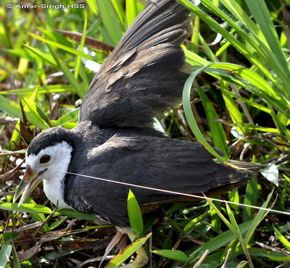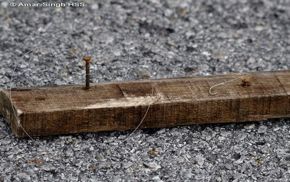Dato’ Dr Amar-Singh HSS encountered a hooked White-breasted Waterhen (Amaurornis phoenicurus phoenicurus) near his home in Canning Garden, Ipoh, Perak, Malaysia on 22nd August 2010 and wrote:
“I met this very unpleasant piece of work this morning. It was the first encounter for the day. Saw what appeared to be an injured White-breasted Waterhen at the edge of the bushes (left top). On inspection I thought it had snagged itself on some fishing twine. Closer inspection showed that this was a crude but effective trap that some evil person had devised.
“In searching the area I subsequently discovered another similar trap (left bottom). Some fishing twine is anchored to a heavy piece of wood and a hook attached at one end. The hook is baited with some food and, when the waterhen eats it, it is impaled in the throat.
“I took my camouflage cloth and covered the frantic bird to quieten it. I then tried to remove the hook but it had stuck too deep in the oesophagus. It already looked unwell and any attempt to pull it out would have resulted in death. I considered a number of options and again wished again that we had a bird/animal hospital. It definitely needed major surgery.
“I finally decided to cut the twine close to the mouth and let the poor bird free. Not the best option as it may well die of starvation but at least in the wild
“Not pleased with myself but extremely angry with these individuals who can inflict such harm to animals. I destroyed both traps but this is not the end of it. I have noticed in recent years an increased onslaught on our wild life due to many factors – one being a rising migrant work force. Have spotted some migrant workers, who are generally poorly paid, supplementing their income with catching wild life (not that Malaysian do not do the same!).”
K. Fletcher responded… “I found the following advice on getting a fishing hook out of a bird’s throat: don’t think I could manage it myself but probably a vet could if the bird could be transported to them.
“The Canadian Wildlife Service provides the following bird handling guidelines:
“Seabirds have strongly pointed or hooked bills and will inflict damage to a person’s hand or body. Before handling a bird, it may be advisable to put on a pair of gloves. NEVER HOLD A BIRD CLOSE TO YOUR EYES. Get the bird on board as quickly and gently as possible and, depending upon the size of the bird, seize the bill (large birds like an albatross) or immobilize their wings (medium to small birds like fulmars, shearwaters, auks, gulls).
1. Grab the bill.
2. Restrain the wings to prevent flapping.
3. Determine location of hook.
4. Cut barbed end off with pliers.
5. Remove hook from body or bill.
6. If hooks were swallowed, do not remove hook backward up a bird’s throat.
7. First, attempt to reach down the bird’s throat and remove the hook.
8. If unable to reach hook, make a small (1-2 cm) incision in the bird’s neck and pull out the hook.
9. If an incision is made, place bird in a dark, clean, dry box for 1-2 hours to let it recover. Return to the water only during the daylight hours.
“A different technique is suggested here: http://www.anapsid.org/fishhook.html
“As far as I can tell neither the old or the new Malaysian Protection of Wildlife Acts provide any penalties for trapping birds unless the bird is a protected species (though there are penalties for even possession of snares).”
Chan Ah Lak wrote: “If the hook is visible (impaled) in the mouth, it would be quite easy to cut off the barb and remove the hook, after restraining the bird. This is what doctors do to remove hooks from fingers of careless anglers.
“If the hook is not visible it is probably lodged down the throat and it would have punctured the esophagus in the process and will give rise to infection, very similar if you accidentally swallow a fish bone and it got stuck in the esophagus! I think to save the bird you have to take it to a vet.
“Removing the hook with a catheter is possible but you still got to treat for secondary infection. For humans, I normally give them an Anti Tetanus injection, some analgesics and a course of antibiotics to prevent secondary infection.”










